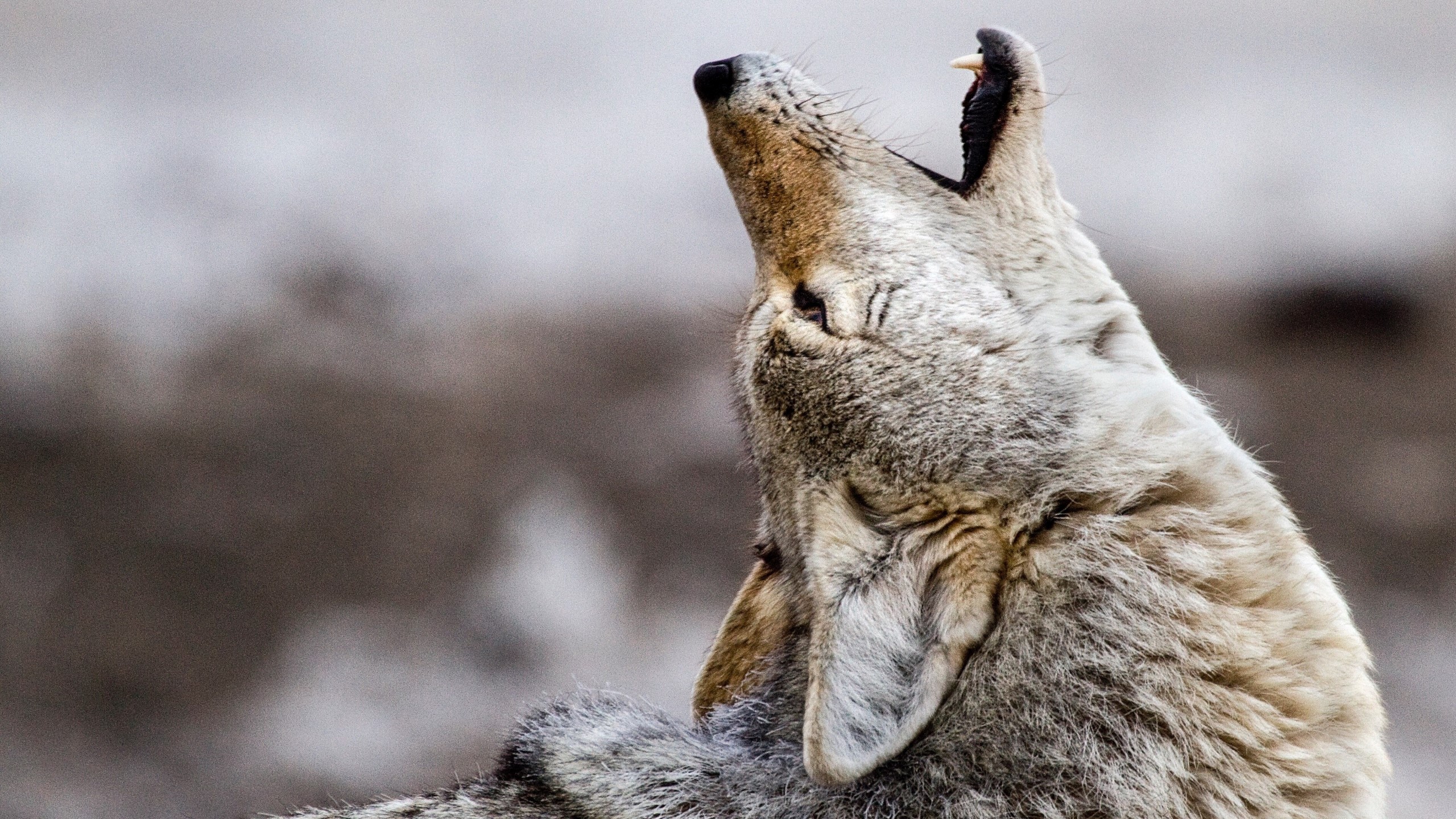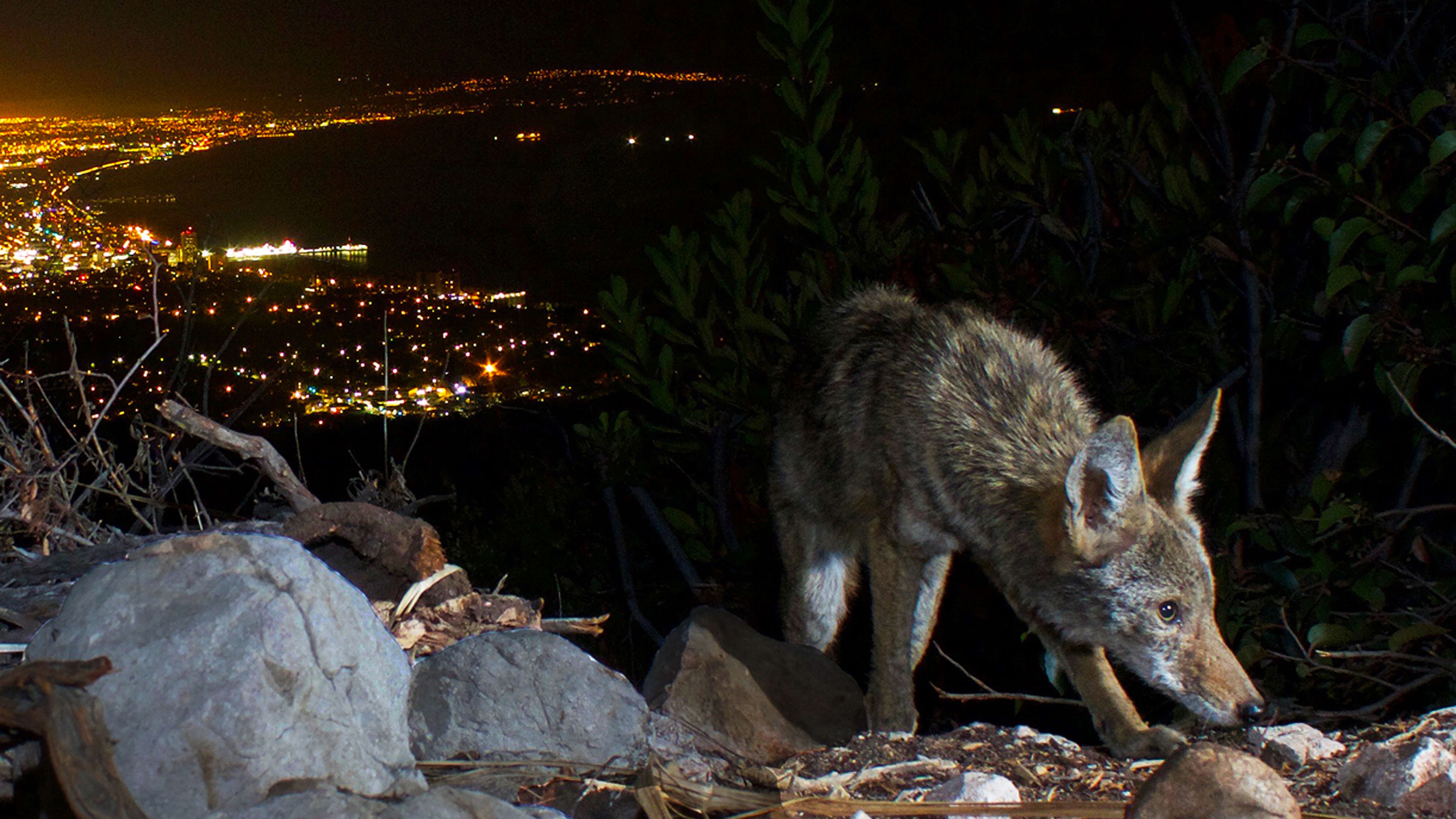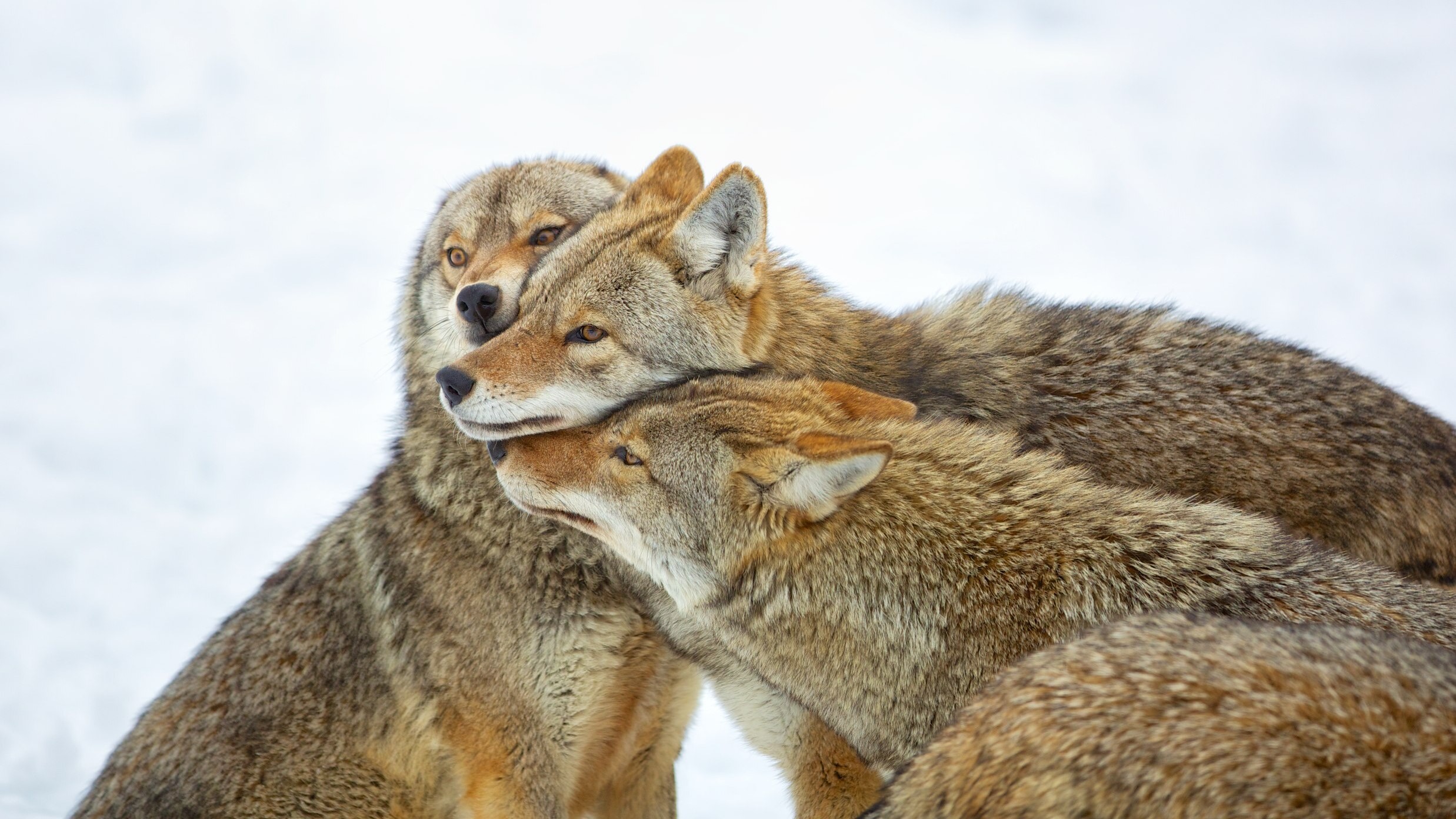Coyotes: Facts about the wily members of the Canidae family

Coyotes (Canis latrans) are members of the Canidae family and share many traits with their relatives — wolves, dogs, foxes and jackals. They have narrow snouts, lean bodies, yellow eyes, bushy tails and thick fur.
Labeled "wily" by humans, coyotes are intelligent and versatile creatures. These traits have helped coyotes spread across North America and even adapt to living alongside people in cities. Despite a sometimes rocky relationship with humans, the continental coyote population continues to thrive.
How big is a coyote?
Coyotes are about as big as medium-size dogs. They are 32 to 37 inches (81 to 94 centimeters) long from head to rump, plus another 16 inches (41 cm) for their tails, according to National Geographic. Coyotes typically weigh 20 to 50 lbs. (9 to 23 kilograms).
Coyotes are smaller than wolves. For example, a coyote skull rarely exceeds 7.9 inches (20 cm) in length, while wolf skulls are commonly over 8.9 inches (22.5 cm), according to the San Diego Natural History Museum. Coyotes' fur may be gray, white, tan or brown, depending on where they live.
Related: How coyotes dwindled to their modern size.
Where do coyotes live?
Coyotes live across North America and roam the plains, forests, mountains and deserts of Canada, the United States, Mexico and Central America. They have colonized all of the continent except for the polar regions, and continue to move south — so much so that they are approaching the border between Central and South America in eastern Panama, according to the International Union for Conservation of Nature’s (IUCN) Red List.
Size: Up to about 53 inches (135 cm) long
Life span: 5 to 6 years
Conservation status: Least concern
The species was originally only found in the prairies and deserts of central and western North America. Humans helped facilitate their expansion in the 1800s both by creating more open habitats through logging and agricultural development, and also hunting out wolves and cougars, which are natural coyote competitors, Live Science previously reported. As humans took over more and more countryside, coyotes adapted to live in cities. Today, coyote populations are thriving in big cities from Los Angeles to New York.
What do coyotes eat?

Coyotes are not picky eaters. They hunt and eat small prey, such as rodents, rabbits and squirrels, as well as insects and fruit, depending on what is available to them. Coyotes can also work together to kill deer, according to the Atlanta Coyote Project.
Opportunistic coyotes will take advantage of pet food, garbage and other food left out by humans, especially in urban environments. They have also been known to hunt livestock and human pets, such as dogs and cats.
Related: Urban coyotes could set the stage for larger predators in cities.
Predatory coyotes can still become prey themselves. Cougars, wolves, grizzly bears and black bears are known to kill coyotes, according to the U.S. Department of Agriculture Forest Service. Golden eagles have been known to swoop down and take young coyotes. Humans kill coyotes too, for their fur and in attempts to control their populations.
Do coyotes attack humans?
Coyotes generally avoid people, but occasionally they will attack. In a few cases, coyotes have learned to associate humans with food in urban environments, making them bolder around people.
Related: Why are there so many coyotes in cities?
There were 367 coyote attacks on humans between 1977 and 2015 in the U.S. and Canada, according to research published in 2017 in the journal Human–Wildlife Interactions. These attacks were largely in urban and suburban environments. Only two of the attacks were fatal.
The most effective way for humans to prevent coyote attacks is to avoid feeding them directly or indirectly, according to the Cook County Coyote Project in Illinois. The project also advises people to not let their pets run loose and to keep their yards secured. During a coyote encounter, the project recommends that people try to scare the animal away. However, if a coyote is trying to avoid people, then humans should not deliberately aggravate it.
How do coyotes hunt and socialize?

Coyotes typically hunt alone or in pairs unless they are working together to kill deer. When hunting deer, groups of coyotes can take turns pursuing their prey until it tires, or they may drive the deer toward a hidden member of the pack, according to the University of Michigan’s Animal Diversity Web (ADW). Coyotes can reach speeds of up to 40 mph (65 km/h).
Kingdom: Animalia
Phylum: Chordata
Class: Mammalia
Order: Carnivora
Family: Canidae
Genus: Canis
Species: latrans
Usually most active at dawn and dusk, coyotes can also be nocturnal, meaning they sleep during the day and hunt at night, according to the University of Florida’s Institute of Food and Agricultural Sciences (IFAS). However, they are adaptable creatures. In cities and other urban environments, coyotes have been known to modify their day and night cycle to better avoid humans and traffic.
While individual coyotes are often seen traveling and hunting alone or in pairs, they are typically part of a larger pack. These packs defend their territories from other coyotes and are usually made up of an alpha male and female pairing and their close relatives, according to the Cook County Coyote Project.
Coyotes use sounds to communicate, including yips, barks and howls, as well as scents and visual signals. The iconic coyote howl is likely used to announce one pack’s territorial boundaries to other packs. Pack members will also howl at each other when they reunite, according to the ADW.
Coyote breeding

The coyote breeding season runs from January to March each year. In the spring, female coyotes build dens in preparation for their young. Females have a gestation period of about 63 days and give birth to groups of six pups on average. The groups of pups are called litters.
Both the males and females in a pack participate in taking care of the pups. The male will bring food to the female and the pups, and help protect them from predators. Coyote pups are born blind in the den and are totally reliant on their mothers. Their eyes open after 10 days, and within a month they begin to emerge from the den, according to ADW. Young males will leave their parents within 9 months, while females typically stay with their parents, forming the basis of a pack.
Pups reach adulthood and sexual maturity within a year of being born. Coyotes typically live for around 5 to 6 years in the wild, and have been known to reach a maximum lifespan of up to 12 years. They can live longer in captivity — the oldest known individual lived for 18 to 19 years, according to IFAS.
Are there different types of coyote?
There are 19 different subspecies of coyote, according to the Integrated Taxonomic Information System (ITIS). The size and coat color of coyotes varies slightly across these subspecies. For example, coyotes that live in the mountains have darker coats, while ones that live in the desert have lighter coats.
The 19 subspecies are:
- Canis latrans cagottis (Mexican coyote)
- Canis latrans clepticus (San Pedro Martir coyote)
- Canis latrans dickeyi (Salvador coyote)
- Canis latrans frustror (south-eastern coyote)
- Canis latrans goldmani (Belize coyote)
- Canis latrans hondurensis (Honduras coyote)
- Canis latrans impavidus (Durango coyote)
- Canis latrans incolatus (northern coyote)
- Canis latrans jamesi (Tiburón Island coyote)
- Canis latrans latrans (plains coyote)
- Canis latrans lestes (mountain coyote)
- Canis latrans mearnsi (Mearns coyote)
- Canis latrans microdon (Lower Rio Grande coyote)
- Canis latrans ochropus (California valley coyote)
- Canis latrans peninsulae (peninsula coyote)
- Canis latrans texensis (Texas plains coyote)
- Canis latrans thamnos (north-eastern coyote)
- Canis latrans umpquensis (northwest coast coyote)
- Canis latrans vigilis (Colima coyote)
Coyotes are capable of mating with dogs and wolves, producing hybrid offspring known as coydogs and coywolves. However, these hybrids are unlikely to occur in the wild. The eastern coyote is sometimes called a coywolf or coydog because they interbred with wolves and dogs many generations ago, during coyote expansion across North America, Live Science previously reported. However, there is no evidence to suggest they are still interbreeding.
Related: There’s only one true wolf species in North America. The rest are hybrids.
Are coyotes endangered?
Coyotes are not endangered. They are abundant across a large range of North America, and according to the IUCN, the population is increasing. In some cases, humans have temporarily reduced local populations, but coyotes quickly recover through migration and reproduction. Humans kill over 400,000 coyotes every year, about 80,000 of which are exterminated by the U.S. federal government, according to National Geographic.
Coyotes in culture
Coyotes are associated with the character Coyote, which has an important place in the mythology and religion of multiple indigenous groups in North America. Coyote is typically a trickster figure, often attempting to manipulate other animals and beings. However, there are many different coyote tales. For example, Coyote plays a particularly significant role in the mythology of the Navajo of the southwestern U.S. In Navajo tradition, Coyote is an important figure in the creation of the world and can represent both good and evil, according to 1987 research published in The Canadian Journal of Native Studies.
Related: The weird tale of a larger-than-life wolf that outran the law, almost
A coyote was the basis for the Wile E. Coyote character in the popular “Looney Tunes” animated series. Wile E. was the nemesis of the Road Runner, based on the roadrunner bird. Unlike real coyotes, the fictional Wile E. was frequently let down by his own ineptitude or equipment as he relentlessly pursued the Road Runner. Real coyotes will predate on roadrunners, but not as obsessively as in the cartoon. Live Science previously reported that greater roadrunners can run at 15 miles per hour (24 km/h), which means coyotes are actually faster.
Additional resources
- The Conversation: How coyotes and humans can learn to coexist in cities
- Rutgers University: Coyotes in New Jersey
- Smithsonian Magazine: Coyotes poised to infiltrate South America
This article was updated on April 2, 2021 by Live Science staff writer, Patrick Pester.
Sign up for the Live Science daily newsletter now
Get the world’s most fascinating discoveries delivered straight to your inbox.











